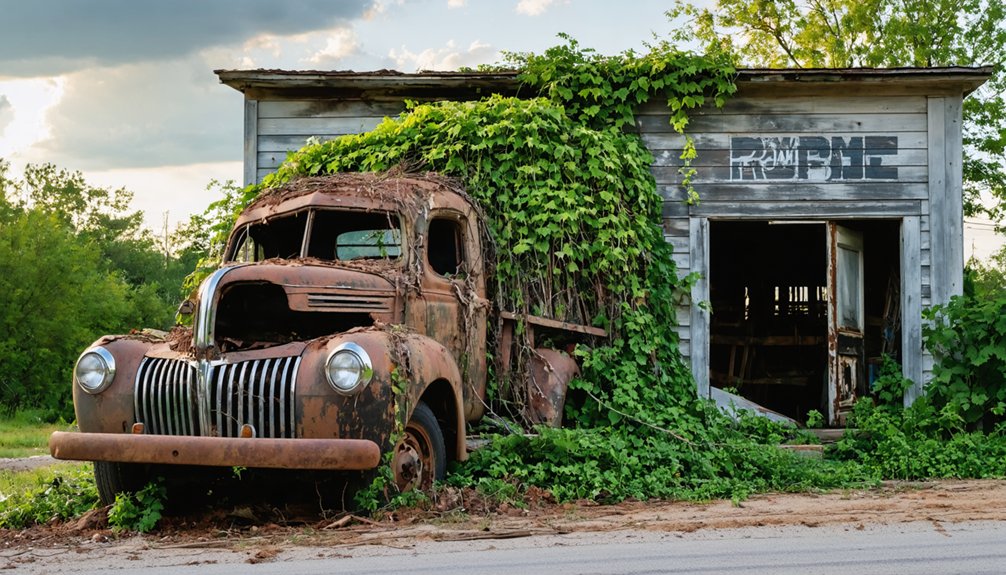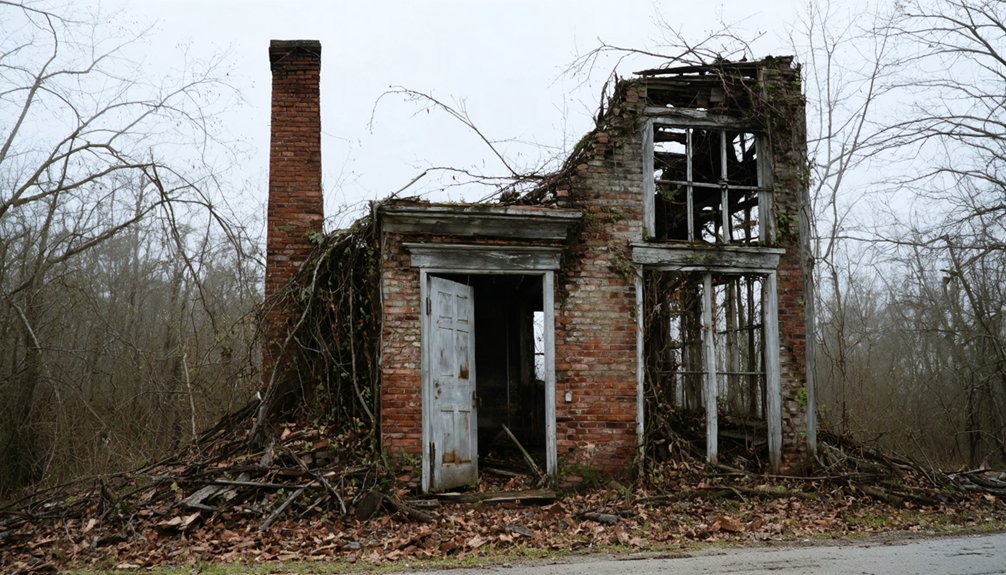You’ll discover Centerdale nestled in Alabama’s historic mining country, established in 1878 as a railroad whistle stop. The town flourished through cotton farming and mining operations, with the Tennessee Coal, Iron and Railroad Company playing an essential role in its development. Though now abandoned, you can explore the atmospheric ruins while observing local wildlife. The site’s crumbling foundations and rusted railway tracks hold fascinating stories of Alabama’s industrial past.
Key Takeaways
- Centerdale emerged as a railroad whistle stop in late 19th century Alabama, established in 1878 with focus on mining and transportation.
- The town’s early economy centered on cotton farming, local trade, and mining operations utilizing convict labor systems.
- Residents gathered at churches, general stores, and community halls, forming tight-knit social bonds through various communal activities.
- Economic decline occurred when transportation routes bypassed the town, coupled with resource depletion and inability to compete with larger cities.
- Now a ghost town, Centerdale features historic remnants and serves as habitat for local wildlife, attracting history enthusiasts and photographers.
Historical Roots and Settlement Origins
While many Alabama ghost towns emerged from the state’s railroad expansion in the late 19th century, Centerdale’s origins can be traced to its strategic location at the intersection of Old Railroad Bed and Baites Roads.
As a whistle stop along the railway line, you’ll find settlement patterns typical of northern Alabama’s rural development, where transportation corridors drove community evolution.
The town’s establishment mirrored the region’s broader shift from Native American territories to European-American settlements, much like the historic ancient Native settlement of Maubila.
Near the vanished community of Dan and the ancient settlement of Maubila, Centerdale’s location by Silver Run Creek provided crucial water resources for agriculture and daily life.
Like many small crossroads communities of its era, the town served as a key link in the local trade network, supporting the area’s growing rural population.
The area was originally named Silver Run before undergoing a name change to honor a local colonel.
Life in Early Centerdale
Life in early Centerdale centered around daily community activities, where you’d find settlers gathering at local meeting points to exchange news and goods while strengthening their social bonds.
You’d see horse-drawn wagons and carts moving along the dirt roads that connected Centerdale to neighboring settlements, establishing essential trade routes for agricultural products and household necessities. The fertile valley soil made the area particularly attractive to early settlers looking to establish profitable farms.
Your journey through early Centerdale would reveal a community that relied heavily on river access for larger-scale commerce, with local farmers and merchants using these waterways to transport cotton and other goods to broader markets. The crucial transportation system depended on river barges and flatboats to move cotton products efficiently to the Port of Mobile.
Daily Community Activities
The rhythmic pulse of early Centerdale revolved around agricultural cycles, community gatherings, and mutual support systems.
You’d find residents coming together at churches, general stores, and community halls to share news, make decisions, and strengthen social bonds. Community events ranged from weekly church services to seasonal festivals, while social gatherings often centered around cooperative activities like barn raisings and firewood deliveries. Much like the historic Fort Gaines museum, the local meeting hall preserved important community artifacts and memories. Similar to Brown Cross Roads, the town developed around key intersections that served as natural gathering points.
Your daily routine would’ve included tending to crops and livestock, with the whole family pitching in after school hours. Local craftsmen supplemented their farming income through trades like blacksmithing and carpentry.
The community’s spirit of mutual aid guaranteed everyone’s survival, as neighbors helped each other through hardships and celebrated successes together at picnics, holiday celebrations, and informal meetups at the local country store.
Transportation and Trade Routes
During Centerdale’s early development, a network of dirt roads and horse trails connected the community to neighboring settlements, with the nearest stagecoach stop located 12 miles east in Morton’s Landing.
The transportation evolution of Centerdale relied heavily on horseback travel and wagon routes, which local farmers used to transport their agricultural products to regional markets. Similar to the early residents of Brady who floated timber logs downstream to the sawmills, these transportation methods were vital to the local economy. Like many Alabama ghost towns that were established near river crossings, Centerdale’s location facilitated trade between neighboring communities.
The trade significance of Centerdale centered on its agricultural exports, primarily cotton and corn.
You’d find merchants traveling between Centerdale and larger towns, bringing back essential supplies like tools, textiles, and household goods that weren’t produced locally.
Without direct rail access, the community depended on these established trade routes for economic survival, though this limited transportation infrastructure eventually contributed to the town’s decline as railroad-connected communities flourished elsewhere.
Economic Developments and Industries
As you explore Centerdale’s economic history, you’ll find that early commerce revolved around essential trade at local general stores and small-scale merchants who served the rural community.
The region’s agricultural sector thrived through cotton farming and other crops, supporting the town’s growth during its early development period. The town’s development coincided with Alabama’s broader industrial growth, which included The Magic City Birmingham’s rapid expansion into a major steel production hub. Like the nearby town of Battelle, which suffered from having insufficient mineral deposits compared to Birmingham, Centerdale faced challenges competing with larger industrial centers.
While mining wasn’t central to Centerdale’s economy, the town benefited from the broader industrial expansion happening across Alabama during the late 19th and early 20th centuries.
Early Trade and Commerce
From its earliest days, Centerdale’s economic foundations rested firmly on Alabama’s thriving cotton industry, which expanded rapidly after the cotton gin’s invention made short-staple cotton profitable.
You’d have seen local trade networks developing as merchants established businesses around cotton production and shipping. River barges and flatboats carried cotton bales down to Mobile’s bustling port, while goods like cutlery and cloth made their way back upriver.
The commerce evolution in Centerdale reflected the broader regional patterns, with craftsmen setting up workshops for furniture-making, blacksmithing, and saddle production.
You would’ve found Frank Chotard’s ferry service essential for crossing the Cahaba River, connecting Centerdale’s merchants to critical market centers like Huntsville and Mobile.
Mining and Resource Industries
The discovery of rich coal deposits in the Birmingham area transformed Centerdale’s economic landscape during the 1850s, though systematic mining wouldn’t begin until the 1870s.
You’d find four major bituminous coalfields surrounding the town, with the Warrior field being the largest. Coal production ramped up considerably when the Pratt Coal and Coke Company established operations in 1878, building essential railroad connections and opening several mines.
Labor dynamics in Centerdale’s mines were harsh, relying heavily on leased convict labor. By 1876, you’d see three-quarters of Alabama’s state inmates working in local mines.
The Tennessee Coal, Iron and Railroad Company later dominated the scene after acquiring Pratt Coal in 1886, controlling vast coal lands and maintaining strict oversight of company towns through private enforcement.
Agricultural Production Activities
While coal mining dominated Centerdale’s later years, agricultural production initially shaped the town’s economic foundation through cotton cultivation and livestock operations.
You’ll find that local farmers embraced traditional practices common throughout Alabama’s Black Belt region, though they eventually faced challenges with soil erosion from repeated cotton planting. As agricultural methods evolved, Centerdale’s farmers adapted by implementing crop rotation and sustainable farming techniques.
- Cotton production flourished during the plantation era, utilizing enslaved labor until the Civil War’s end, after which sharecropping became prevalent.
- Livestock operations, particularly cattle raising, thrived in the area’s favorable climate with minimal fencing requirements.
- The shift to more sustainable practices included diversifying into corn and peanuts, though these efforts couldn’t prevent the town’s eventual decline.
Notable Buildings and Infrastructure
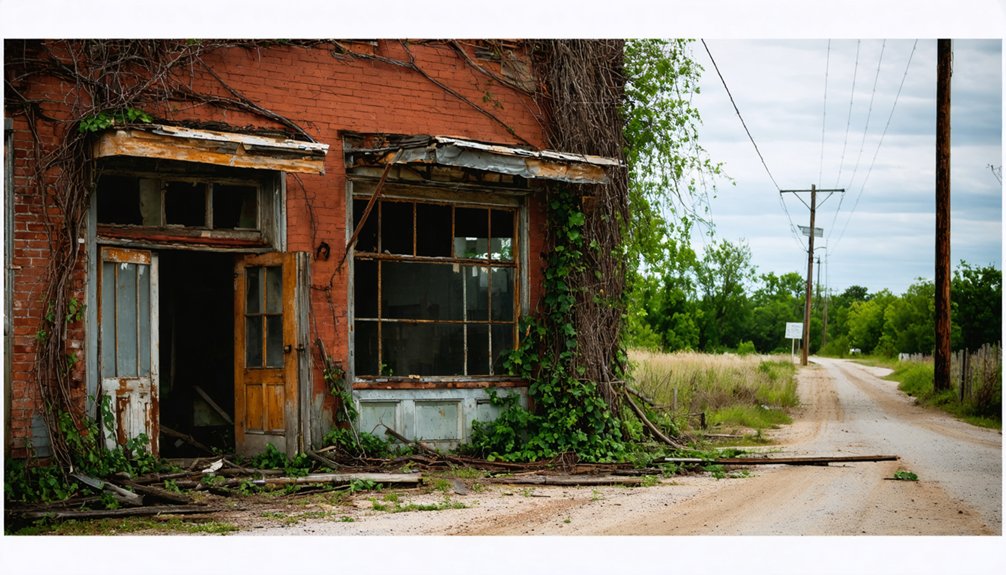
Located along a historic north-south trading route, Centerdale’s notable buildings reflect the typical architectural styles of early 20th century rural Alabama.
You’ll find brick-faced historic buildings with large storefront windows lining what was once a bustling commercial district. Two former drug stores anchored opposite ends of the main strip until fires claimed them during the town’s decline. The most prominent structure, originally a general store, later served as the post office until the mid-1990s.
Infrastructure decay is evident throughout the area, with deteriorating utility systems and crumbling pavement.
The surrounding residential areas showcase weathered farmhouses, bungalows, and Craftsman-style homes, all showing signs of abandonment through sagging porches and peeling paint.
While the buildings stand empty, they serve as silent witnesses to Centerdale’s more prosperous past.
Community Culture and Social Life
Beyond Centerdale’s weathered buildings lay a close-knit rural society typical of early 20th century Alabama settlements. You’d find a community bound together by necessity and tradition, where social networks formed through shared labor and seasonal celebrations.
Family farms dotted the landscape, with daily life revolving around agricultural rhythms and mutual support among neighbors.
The heart of Centerdale’s social fabric consisted of:
Social connections in Centerdale emerged through community gatherings, trade trips to neighboring towns, and seasonal celebrations that united families.
- Informal community gatherings like barn raisings and quilting bees
- Regular travel to neighboring towns for trade and essential services
- Seasonal festivities that brought families together for harvest celebrations
Without formal institutions, residents relied on home-based gatherings and nearby towns for religious services and civic activities. This independence fostered strong interpersonal bonds, though it ultimately couldn’t prevent the town’s gradual decline as younger generations sought opportunities elsewhere.
Factors Leading to Abandonment
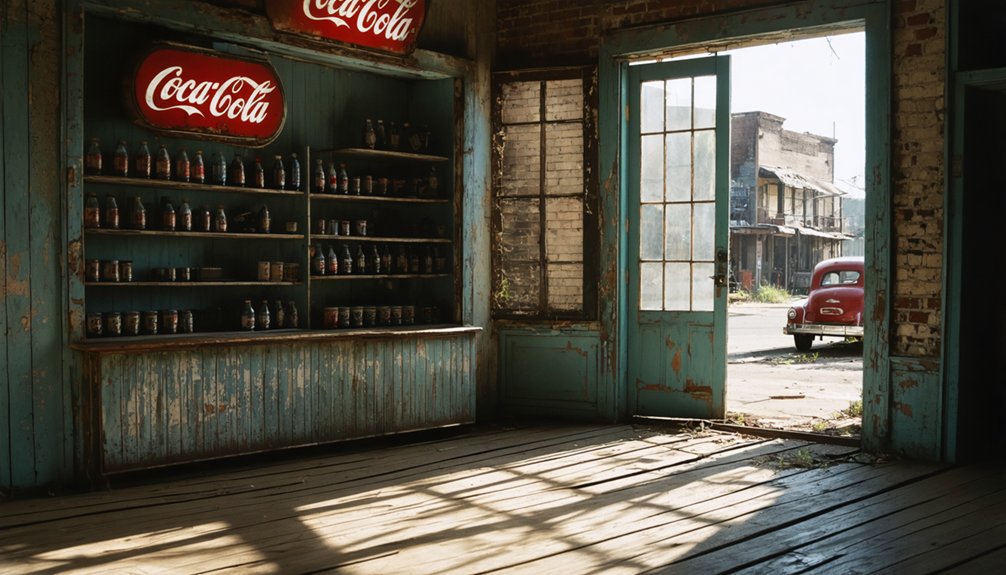
As multiple economic and social forces converged in the early 20th century, Centerdale’s transformation into a ghost town accelerated through five primary factors.
You’ll find the ghost town dynamics followed patterns common to many Alabama settlements. The abandonment causes typically began with shifts in transportation routes that bypassed the town, cutting off essential trade.
When administrative functions moved to neighboring communities, Centerdale lost its economic momentum. Public health crises, including disease outbreaks, drove away residents seeking safer environments.
The town’s dependency on local natural resources proved unsustainable once those materials were depleted.
Finally, like Battelle’s experience with iron production, Centerdale couldn’t compete when newer industrial developments emerged in larger cities, leading businesses to close and forcing residents to seek opportunities elsewhere.
Archaeological Discoveries and Remains
The archaeological record of Centerdale remains largely unexplored, though contemporary research methods offer promising ways to understand this abandoned settlement.
While specific discoveries haven’t been documented, archaeological techniques common to Alabama ghost towns could reveal valuable insights about Centerdale’s past. Ground-penetrating radar and systematic test holes would be essential tools for any future investigation.
- Surface surveys could uncover artifacts similar to those found at Old Cahawba, including pottery fragments and building foundations.
- Test excavations might reveal evidence of early agricultural practices and settlement patterns typical of Alabama’s ghost towns.
- Archaeological analysis could determine the site’s connection to Native American settlements and early European exploration.
You’ll find that these potential discoveries could greatly enhance our understanding of Centerdale’s role in Alabama’s rich historical tapestry.
Preservation Efforts and Current Status
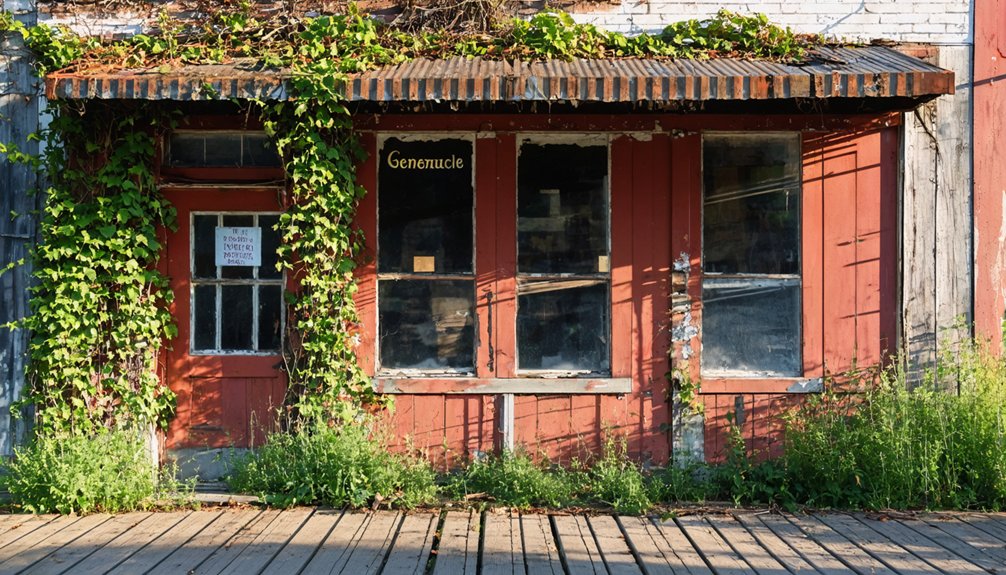
While preservation efforts for Centerdale face significant challenges, Alabama’s Historical Commission has implemented several initiatives to protect this historic site. Through partnerships with local governments and specialized maritime law firms, preservation techniques now focus on documenting the town’s remaining structures and securing legal protections for culturally significant areas.
Alabama’s Historical Commission leads vital preservation work in Centerdale, partnering with local entities to protect and document this significant historic site.
You’ll find community involvement plays an essential role in Centerdale’s preservation, with descendants actively participating in site stewardship and advocating for access rights.
The AHC provides standardized documentation models and competitive grants to support local preservation efforts, while encouraging updates to historic nominations. They’re particularly focused on integrating Centerdale’s historic resources into regional planning decisions and ensuring the site’s history is properly recorded for future generations.
Current preservation status relies heavily on continued funding and legal support to maintain site integrity.
Visiting the Ghost Town Today
Today’s visitors to Centerdale encounter a hauntingly beautiful tribute to Alabama’s bygone industrial era.
You’ll find a raw, untamed landscape where nature has slowly reclaimed the remnants of this once-thriving community. Through guided exploration, you can discover architectural treasures and hidden historical gems while enjoying unique wildlife observation opportunities.
- Navigate the town’s abandoned structures safely by joining organized tours that highlight Centerdale’s rich industrial heritage and architectural significance.
- Capture stunning photographs of deteriorating buildings intertwined with flourishing vegetation, particularly during golden hour.
- Experience the remarkable transformation of former industrial spaces into natural habitats, where deer, birds, and small mammals now make their home.
Remember to respect local regulations and maintain appropriate safety precautions during your visit to this atmospheric piece of Alabama history.
Frequently Asked Questions
Were There Any Significant Natural Disasters That Affected Centerdale’s Population?
You won’t find documented evidence of tornado impact or flood history affecting this population. Historical records don’t show any significant natural disasters contributing to the town’s eventual abandonment.
What Native American Tribes Originally Inhabited the Centerdale Area?
Like ripples on ancient waters, you’ll find the Creek Confederacy was the primary tribe in Centerdale’s area, with their powerful towns dotting the riverways, while Alabama-Coushatta and smaller Muskogean groups also called it home.
Did Centerdale Have Any Connections to the Underground Railroad?
You won’t find documented evidence of Underground Railroad activity in Centerdale, though Alabama’s waterways provided escape routes. Historical significance of the region’s freedom networks remains largely unexplored and undocumented.
Were There Any Famous Historical Figures Who Visited Centerdale?
You won’t find records of any famous visitors to this location, as historical documentation is particularly sparse. While the town held local historical significance, no evidence supports visits from prominent figures.
Did Centerdale Residents Relocate to Specific Nearby Towns After Abandonment?
Where did these frontier families vanish to? You can’t track specific relocation patterns since there’s no historical evidence showing which nearby communities Centerdale’s residents moved to after the 1918 abandonment.
References
- https://en.wikipedia.org/wiki/List_of_ghost_towns_in_Alabama
- https://digitalalabama.com/alabama-ghost-towns/alabama-ghost-towns/9449
- https://deepsouthurbex.com/2020/01/02/6-south-alabama-ghost-towns/
- https://www.tripadvisor.com/ShowUserReviews-g30754-d3405413-r702542512-Old_Cahawba_Archaeological_Park-Orrville_Alabama.html
- https://kellykazek.com/2020/04/10/looking-for-the-history-of-this-little-ghost-town-in-north-alabama-can-you-help/
- https://sites.rootsweb.com/~alghstwn/randolph.html
- http://www.themosttraveled.com/courthouse.html
- https://www.thetravel.com/cahawba-alabama-first-state-capital-abandoned-ghost-town/
- https://www.youtube.com/watch?v=q30HY-NlrSs
- https://alabamabucketlist.com/ghost-towns-in-alabama/


